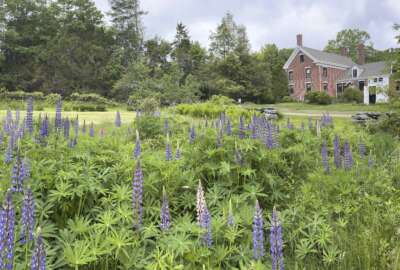New Smithsonian museum expresses its mission in its logo
Jorge Zamanillo, director of the National Museum of the American Latino, says the new logo is symbolic of many things for Latino communities across the U.S.
The National Museum of the American Latino established by Congress in 2020 doesn’t have a building of its own yet. But it just unveiled something that helps establish its presence in the meantime: a new logo called The Iris. For more about the logo and the museum’s progress generally, its director, Jorge Zamanillo, spoke to the Federal Drive with Tom Temin.
Jorge Zamanillo, director of the National Museum of the American Latino says The Iris symbolizes the vision needed to facilitate the interconnectedness of U.S. Latino communities.
Interview transcript:
Tom Temin Mr. Zamanillo, good to have you with us.
Jorge Zamanillo Thanks for having me.
Tom Temin And before we get to the logo, just give us a progress report on the museum itself. You have presence in one of the other Smithsonian institutions, but you’re trying to get a place in a, you know, structure.
Jorge Zamanillo We are. You know, I’ve been here a little bit over two years now, and we continue to do well, you know, fundraising, building the team, starting to build a collection. But the most important thing for us, of course, is, you know, finding a site for the museum. And while we do that over the next decade, as we build the museum, also we have the Molina Family Latino Gallery, which is located at the National Museum of American History. And in that gallery, we have an exhibition now titled The Center, which covers really 500 years of Latinos in the U.S. And that exhibit will be out through next year. And we’ll keep rotating exhibitions in there over the next decade while we build a museum.
Tom Temin And where are the items, artifacts, things to show, where are they kept in the meantime as you rotate them in and out?
Jorge Zamanillo Yes. So we have items in that exhibition that are on loan from other Smithsonian museums or institutions outside the Smithsonian across the world. So that’s very helpful while we build a collection. So we’re even building storage right now, trying to find storage for to acquire and build this national collection over the next decade where you have thousands of items coming in there will be featured in our new museum.
Tom Temin I guess we have implied, but haven’t stated that Congress may establish a museum, but that doesn’t mean it appropriates enough money to buy land and tilt up a new structure, does it?
Jorge Zamanillo No, it doesn’t. They are, just in the sense that their task is we’re building a museum and we raise half the funds, the money needed for that, and the other half comes in through appropriations. But in order to do that, we still need to find a property right place to to build these new museums that were tasked to build. So right now, there’s a bill that was introduced that will help us as a bipartisan bill that will allow us to build on the National Mall. And that’s very important. So we’re hoping that gets passed this year.
Tom Temin Yeah. Is there a rough location on the mall? Because the mall’s getting filled in, you know, decade by decade.
Jorge Zamanillo It is examining properties, open spaces left. So, you know, we studied over 27 different sites in the past few years to find that ideal location based on transportation corridors, public transportation, visibility, accessibility. So as a site, we identified it, we called the Tidal Basin site, and it’s basically a big field that’s just west of the Holocaust Museum between the Tidal Basin and the Holocaust Museum, just south of Independence. And that’s a site that we feel is an ideal location. And so when we recommended to the border regions our governing board, so now we’re just waiting for permission to build on that site.
Tom Temin Yeah, I know that site. And that’s a thing I think everyone who drives by there or strolls by there or tries to bike by there will recognize it when they see it. And, well, let’s talk about the logo. It’s called the eye, the iris. Tell us more about it and how it got to how it got designed and put into existence.
Jorge Zamanillo Yeah, we’re excited. You know, part of our awareness campaign is brand recognition, new colors, new logo. So we came up with something we’re calling The Iris. And in you know, an eye really symbolizes looking for clarity, right? And in this storyline, you know, providing that vision that we need about unifying and bringing all these stories together, the interconnectedness of Latino communities across the U.S. And so we’re very vibrant and, you know, and kind of enticing to get to learn more. You know, what brings us together in our wilderness. So we’re really, you know, excited about that.
Tom Temin Now, the two main colors, sort of a turquoise and maybe a royal or navy blue. Do those have significance now?
Jorge Zamanillo Right now, they are definitely colors that bring trust into our name, but we have variations on there. So if you see the animation we have in our website, it also shows some more earthy tones and some browns and yellows and some greens in there. And we’ll use different variations of this logo as appropriate. So there definitely are some other vibrant colors that we’re going to bring into the mix.
Tom Temin Who did the design work? How did you I imagine there was you went places to try to find a contractor for that.
Jorge Zamanillo Yeah. Now, we worked with with a couple of different teams and consultants to help build that. And then with the staff and input from stakeholders and board members, you know, we came up with something we felt was this first iteration, right? One of many, right. Because that’s what happens when you build a museum or any kind of company. You have a logo. And then we hopefully when we come up with the design of the building and we have that new stage right in our development, maybe there will be another iteration of that. So this is an ongoing process as we as we evolve over the next decade before we open.
Tom Temin Well, as it looks, I think it would make a heck of a good looking t-shirt, you know, that was on the back?
Jorge Zamanillo Definitely. And we do have a site. We do have merchandise online in our website where you can order T-shirts and mugs and caps and everything else.
Tom Temin All right. Swag. We’re speaking with Jorge Zamanillo. He’s the director of the National Museum of the American Latino. And I want to get a sense of how you conceptualize what should go into a museum. It’s easy for any subgroup of the American experience to render itself as a cliche. But when you really look and you mentioned 500 years of Latino involvement in here in North America in what became the United States, there’s business leaders from all around the world. There was a legendary Cuban president of Coca-Cola. You have people in industry and business as well as the arts and everything else. So how do you how do you get your arms around? What do we say about ourselves, the Latino experience in the United States? You know.
Jorge Zamanillo There’s definitely a lot of stories to highlight. And one of the things that we do in the present exhibition is that we do try to bring out some of those legacies and some of the stories, how they shaped the American history narrative. Everything from, like you said, entertainment to military history. Yes. You know, first astronaut in space, a Latino. It’s amazing. I was talking recently to Ellen Ochoa. She’s the first female Latina pilot in space, but I didn’t realize when I met her in Boise, Idaho. She’s retired there now, but she was also in charge of the Johnson Space Center for many years. She’s director of the Johnson Space Center. She was on three space shuttle missions. So you start having these conversations with these pilot really pioneers in our community and you learn so much more and you realize there really are stories that are not you know, we need we need to bring forward. Right. We need to make sure they have their presence and they have alongside other stories in the on the National Mall. So what we’re doing over the next few years and we started doing this already in the past two years, but we’re going to continue and increase our presence in communities across the United States. We visited over 35 cities, 20 different states with our team. I’ll be visiting a couple of different cities this year alone before the end of the year just to engage with different communities and really connect with people and see what they want to see in a museum, see what’s out there, collect oral histories. Eventually, in a year or so, started collecting initiative to to bring in those, you know. Lonnie Bunch was the current secretary. He was a founding director of the African American History and Culture Museum. And he had a great success with that treasures program, right? Going out into the communities and seeing what’s out there and also helping people learn about preservation and preserving their stories and their and their objects. But I think one of the most important things is also working with other museums and community groups throughout the nation to make sure we have that buy in and trust that’s so important not only to engage now, but to continue that engagement over the next decade and beyond, to make sure we are that kind of community centered museum we want to be.
Tom Temin Right. I think sometimes people overlook the fact of how diverse the museum community is in the United States in terms of size of institutions. And sometimes you run across that little tiny place that’s unbelievable in a local community. Is that the case for, say, Latino types of exhibits and and preservation?
Jorge Zamanillo I think so. You know, there’s only a handful of museums are really dedicated to the Latino story. There’s a Mexican art museum or something that’s more specialized. But but when you really come down to it, there’s nothing that really encapsulates, you know, who we are as a nation. And that’s, you know, that’s a first. And this is a national museum. So there are some expectations for, you know, what a national museum looks like. And we’re actually trying to break that mold. We’re trying to change that up a little bit. Right. We think about this museum when it opens in ten years or so, it’s going to be a completely different museum that would exist today on the National Mall, not only from the appearance and the architecture, but the way we take in content, the way we interact. When a visitor first walks in there, what are they going to see in ten years in a museum, especially with, you know, I’m not saying it’s going to be technology heavy, but we have to realize there are different methods and ways to engage now with technology. So it’s going to be quite a different experience. But African-American history and culture museum start to break that mold, right when you visit the mall. The building even looks different than every other gray concrete building you see along the east west corner there. So it’s good to see that kind of experimentation and kind of pushing the envelope. You know, what can we do to really connect the communities and say this building visually is also a symbol of who we are?
Tom Temin Right. The British Museum of the 1930s is not really the state of the art model anymore, is it?
Jorge Zamanillo Right, exactly.
Tom Temin And you’ve got some events happening in this particular month.
Jorge Zamanillo It is Hispanic Heritage Month for another couple of weeks. And we had an amazing event last Friday for Santa Cruz to launch the quarter, the new quarter, the first Afro-Latino on it. So that was a very successful event. But we also have an event coming up on October 12 where we kick off, where we celebrate Hispanic Heritage Month at American history. And that’s going to be a whole day showcasing Hispanics in sports. So you have an interest and it’s a family friendly event all day with local celebrities and sports athletes from the Olympics and interactive and. Amazing activities all day related to Hispanics and sports.
Tom Temin Well, it sounds exciting. Jorge Zamanillo is director of the National Museum of the American Latino. Thank you so much for joining me.
Jorge Zamanillo Thank you for having me.
Tom Temin And we’ll post this interview along with a link to more information at federalnewsnetwork.com/federaldrive. Subscribe to the Federal Drive wherever you get your podcasts.
Copyright © 2024 Federal News Network. All rights reserved. This website is not intended for users located within the European Economic Area.
Tom Temin is host of the Federal Drive and has been providing insight on federal technology and management issues for more than 30 years.
Follow @tteminWFED






